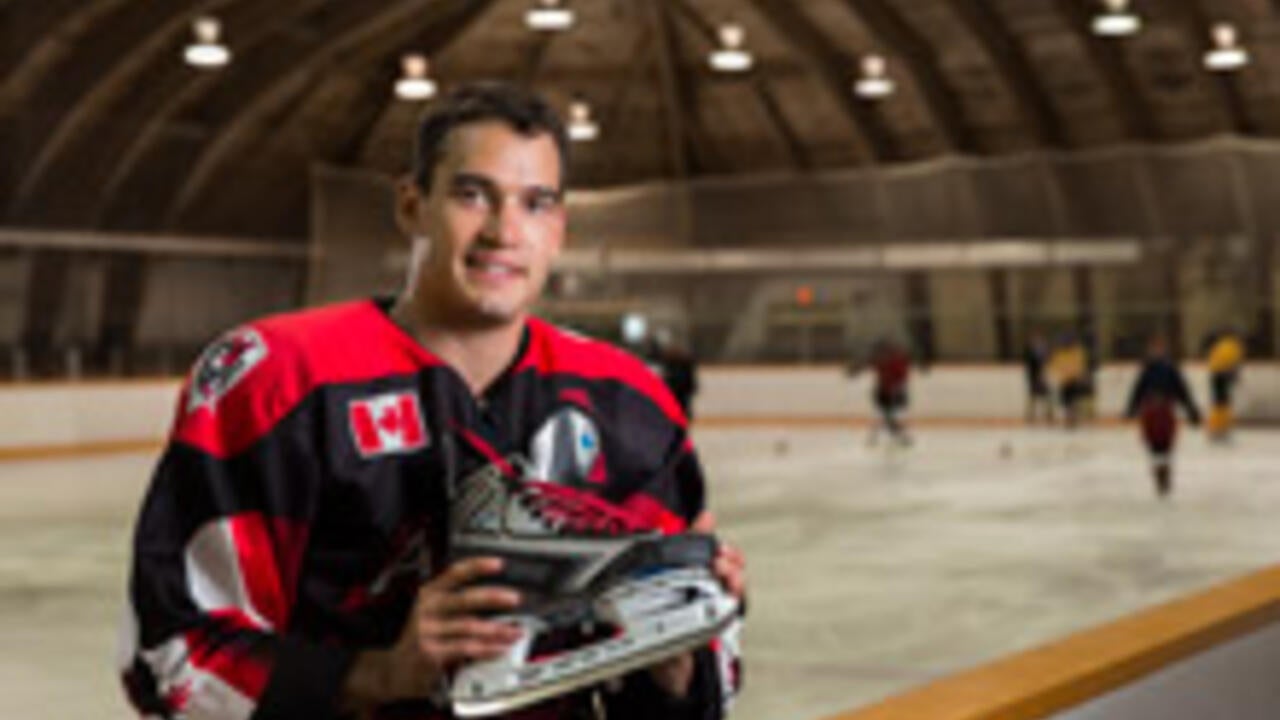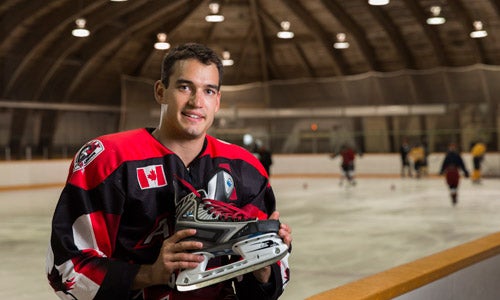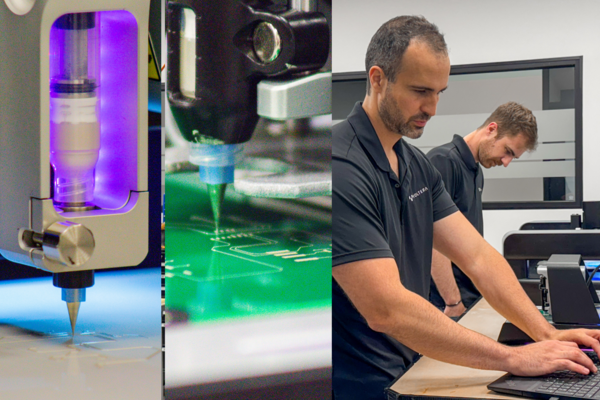
A simple solution relaunches stalled skate-blade startup
New York Islanders defenceman uses innovative skate blade while 14 NHL teams test out the new Bladetech Burner

New York Islanders defenceman uses innovative skate blade while 14 NHL teams test out the new Bladetech Burner
By Brian Caldwell Faculty of Engineering
There were many days Jeffrey Azzolin felt like giving up and moving on to something else.
Two years into his effort to build a better blade for hockey skates, the University of Waterloo graduate was right back to square one, wracking his brain for an entirely new design that would both work and be financially viable.
Azzolin, 26, knew he was on to something with spring-loaded blades to first store energy, then release it to help “launch” skaters at the end of their strides, a concept he hit on as a fourth-year Capstone Design project in mechanical engineering.
But his first prototype, which used an actual coiled spring mechanism, was too expensive to make, too complicated to install and prone to breaking down due to too many moving parts.
“I realized I had to go back to the drawing board,” Azzolin recalls. “It was a very frustrating summer.”
Fuelled in equal parts by a fear of failure and his original desire to make a difference, however, he did extensive research and persevered until finally finding a solution in simplicity.
Instead of adding a cumbersome mechanism to it, Azzolin made the blade itself the all-important spring to store and release energy using the same whipping action as a diving board or a composite hockey stick.
That basic concept had first been kicked around during early brainstorming with University advisors including Oscar Nespoli, a lecturer in mechanical and mechatronics engineering, John McPhee, a systems design engineering professor, and Gary Brock, director of strategic initiatives.
Two years later, the Bladetech Burner is on the feet of one National Hockey League player – Ryan Pulock, a young defenceman with the New York Islanders – while being tested by 14 teams as the 2016-2017 season gets under way.
“The next few weeks will be very interesting to see the feedback of the teams – who likes them, who doesn’t like them, who is placing orders for this year,” says Azzolin. “We’re hungry to turn that one into 10 and that 10 into 100.”
Sales of the replacement blades, which go for $140 a pair, have only numbered about 400 so far, but his company, Bladetech Hockey Inc. of Toronto, now has products in 12 Ontario stores – mostly Source for Sports outlets – and is negotiating with retailers in several other provinces.
Azzolin, who still gets informal advice and guidance from McPhee, the supervisor for his student project, says testing with high-level players has shown a five per cent increase in acceleration, top speed and agility.
Key to the performance of the blades are high-carbon stainless steel, which efficiently stores and releases energy, and a small cut-out that allows them to flex and float within their holders.
When a skater begins a stride, the front, toe portion of the blade moves upwards about 1.5 millimetres. As the player lifts the skate at the end of the stride, that section of the blade then springs back to its original position, helping to propel them in the process.
“We’ve introduced all the flex, energy absorption and energy release within the actual blade itself, which is a pretty innovative and novel thing to do,” Azzolin says.
Blades can be installed in just a few minutes using existing holders on all skate makes and models, a dramatic improvement from the hour-long procedure involved with his original design.
Additional benefits include cushioning to reduce wear and tear on joints - a selling feature for older referees and recreational players – and less frequent skate sharpening since the blades hold their edges longer.
“It was definitely very annoying to start from scratch, but now this has a lot of potential,” Azzolin says. “Once we get more NHL feedback, we can explode out everywhere.”

Read more
Here are the people and events behind some of this year’s most compelling Waterloo stories

Read more
Voltera prints electronics making prototyping faster and more affordable — accelerating research to market-ready solutions

Read more
Discover how Waterloo alumni are driving Canada’s economy with five tech companies making a local and global impact
Read
Engineering stories
Visit
Waterloo Engineering home
Contact
Waterloo Engineering
The University of Waterloo acknowledges that much of our work takes place on the traditional territory of the Neutral, Anishinaabeg, and Haudenosaunee peoples. Our main campus is situated on the Haldimand Tract, the land granted to the Six Nations that includes six miles on each side of the Grand River. Our active work toward reconciliation takes place across our campuses through research, learning, teaching, and community building, and is co-ordinated within the Office of Indigenous Relations.